Simple and effective folk methods of treating onions for various diseases
Onions are a universal remedy that prevents and cures diseases. It is usually prescribed in complex treatment, but it can also be used as part of monotherapy. The vegetable has established itself as an inexpensive, accessible and at the same time effective remedy in the fight against various diseases. Its use has a minimum of side effects and contraindications and is well tolerated by patients.
What are the benefits of onions in treatment?
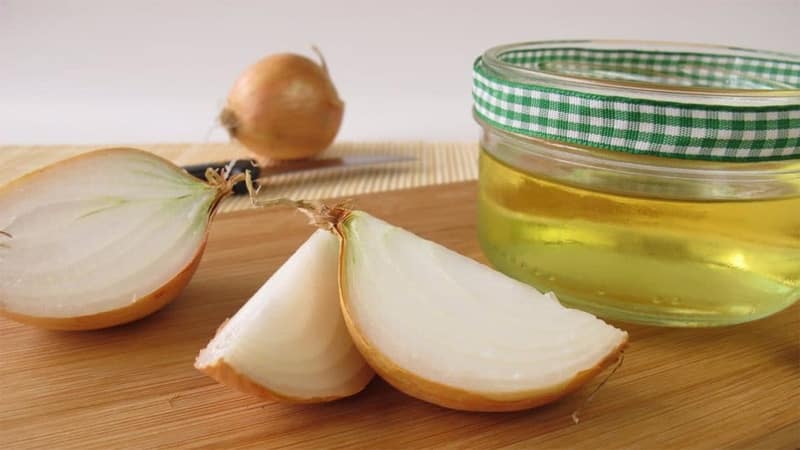
Onion is a vitamin remedy that is used all year round, but especially healthy in autumn-winter period.
Regular consumption of onions helps maintain health, immunity to disease, and in case of illness, a speedy recovery. This is the source vitamins, minerals, amino acids, essential oils, flavonoids and other elements, in the absence of which the body is unable to function normally and resist dangerous bacteria.
Composition and beneficial properties
Content of nutritional elements (proteins, fats, carbohydrates, vitamins and minerals) per 100 g of the edible part of onions:
| Calorie content | 40 kcal |
| Squirrels | 1.1 g |
| Fats | 0.1 g |
| Carbohydrates | 7.64 g |
| Alimentary fiber | 1.7 g |
| Water | 89.11 g |
| Ash | 0.35 g |
| Vitamins | |
| Beta carotene | 0.001 mg |
| Lutein + Zeaxanthin | 4.0 mcg |
| Vitamin B1, thiamine | 0.046 mg |
| Vitamin B2, riboflavin | 0.027 mg |
| Vitamin B4, choline | 6.1 mg |
| Vitamin B5, pantothenic acid | 0.123 mg |
| Vitamin B6, pyridoxine | 0.12 mg |
| Vitamin B9, folates | 19 mcg |
| Vitamin C | 7.4 mg |
| Vitamin E | 0.02 mg |
| Vitamin K | 0.4 mcg |
| Vitamin PP | 0.116 mg |
| Betaine | 0.1 mg |
| Macronutrients | |
| Potassium | 146 mg |
| Calcium | 23 mg |
| Magnesium | 10 mg |
| Sodium | 4 mg |
| Phosphorus | 29 mg |
| Microelements | |
| Iron | 0.21 mg |
| Manganese | 0.129 mg |
| Copper | 39 mcg |
| Selenium | 0.5 mcg |
| Fluorine | 1.1 mcg |
| Zinc | 0.17 mg |
| Digestible carbohydrates | |
| Mono- and disaccharides (sugars) | 4.24 g |
| Glucose (dextrose) | 1.97 g |
| Sucrose | 0.99 g |
| Fructose | 1.29 g |
| Essential amino acids | 0.265 g |
| Nonessential amino acids | 0.446 g |
| Phytosterols | 15 mg |
| Saturated fatty acids | 0.084 g |
| Monounsaturated fatty acids | 0.013 g |
| Polyunsaturated fatty acids | 0.017 g |
The popularity of onions for the treatment and prevention of diseases is due to their mild, harmless nature. impact on the body and almost complete absence of side effects. Due to the presence of various biologically active components in the composition, onions are used as an anti-inflammatory, antiseptic, wound-healing, analgesic, antispasmodic, adsorbent, and diuretic.
Onions are a preventative against atherosclerosis and hypertension. The effect of onions covers the organs of vision, the reproductive system (increases potency, stimulates sperm production, restores ovarian function), and the endocrine glands. Onions are also necessary for the proper functioning of the immune system and slow down the aging process.
What diseases can be treated with onions?
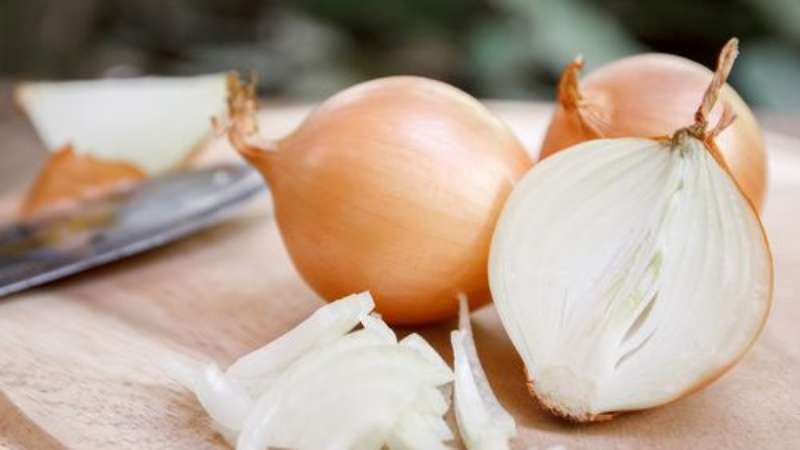
What does onion heal and how to use it correctly? The benefits and contraindications of the vegetable are determined in accordance with the disease in consultation with the attending physician.Traditional medicine suggests using onions to treat diseases of the digestive, urinary, nervous, respiratory systems, musculoskeletal system, heart and blood vessels.
Important! Despite the wide range of actions, the vegetable cannot radically affect the course of the disease. Traditional recipes with its participation help alleviate the severity of symptoms, speed up the recovery process, prevent complications, and delay the onset of relapse.
Ulcers, abscesses, ulcers
Onions have anti-inflammatory, wound-healing, bactericidal properties and act as a powerful antiseptic, effective in the treatment of open wounds on the skin and mucous membranes.
Depending on the nature of inflammation and tissue damage, onions are used as part of monotherapy or combination treatment:
- abscesses;
- boils;
- abscesses;
- ulcers;
- bacterial colpitis;
- mechanical or chemical damage to the skin.
Ear diseases
When there is a feeling of pressure or fullness in the ears, pain in the ear, or decreased hearing, onions eliminate unpleasant symptoms, inhibit the inflammatory process, and reduce the intensity of pain.
In case of otitis of an infectious nature, it has an antibacterial effect - it destroys pathogenic microflora or suppresses its vital activity, and reduces the risk of complications.
Colds
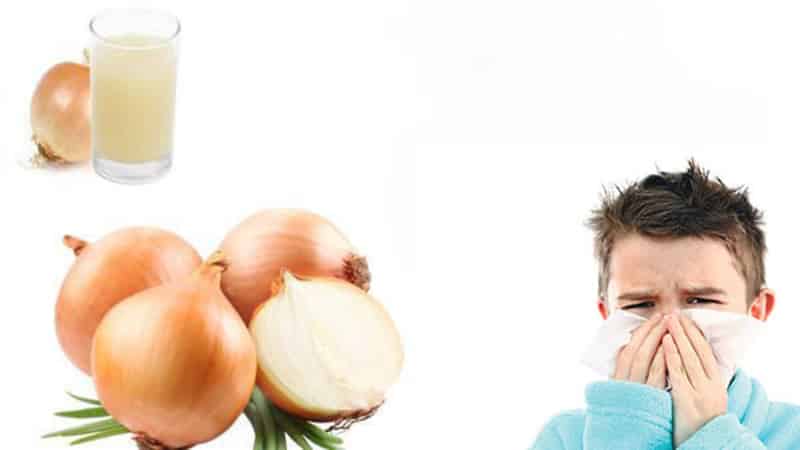
Onions are used for acute respiratory infections, for the treatment and prevention of respiratory diseases: pneumonia, bronchitis, tonsillitis, pharyngitis, bronchiectasis. Infusion and decoction cause sputum dilution, soften cough, and facilitate secretion. Onion-based inhalations stimulate the secretion of the bronchial glands, soothe the cough center in the brain, reduce the inflammatory process of the mucous membrane, and ensure rapid evacuation of liquefied sputum.
Onions are characterized by a pronounced antimicrobial effect. Flavonoids and organic acids in the composition bulbs cleanse the respiratory tract from viruses, bacteria, suppress their growth and reproduction, prevent penetration into the lower parts of the respiratory system.
Skin
Onions are effective for skin diseases. It is used to treat calluses, warts, acne, lichen, fungal skin infections, eczema. The vegetable has a versatile effect - analgesic, antiseptic, sedative, vasodilator, strengthens the immune system, and prevents the proliferation of infectious agents.
For acne, onion regulates the secretion of sebum, relieves inflammation, and accelerates the healing of scars.
Methods of using onions in folk medicine
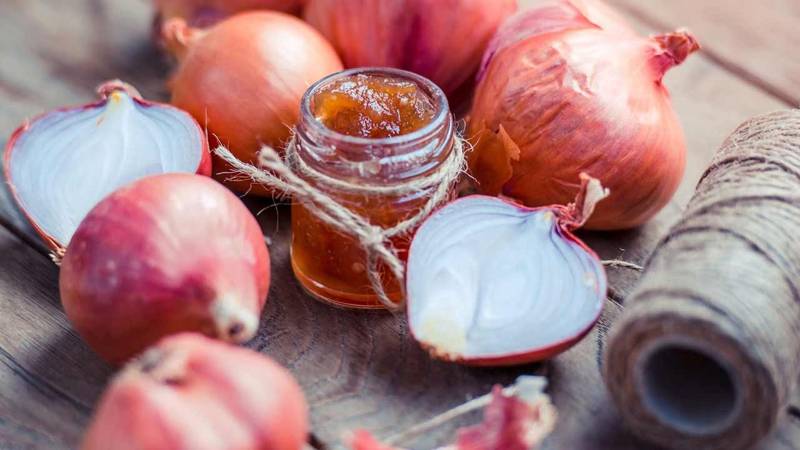
All parts of the plant—bulbs and husks—are used for medicinal purposes. Depending on the type of disease and the causes of its occurrence, onions are eaten or processed into juice, prepare a decoction, infusion. Compresses, lotions, and inhalations are made from onion pulp.
Advice. Ideally, choose root vegetables from your own harvest or grown without the use of nitrates. When buying onions in stores, supermarkets, and the market, pay attention to the external characteristics. A product of proper quality is small in size (5-6 cm), has a dry, shiny husk without signs of spoilage, damage, foreign odors, mustiness, or mold.
Fresh onions
Fresh onions are eaten as a vitamin remedy to protect against flu, colds, and genitourinary infections. Due to their low calorie content and high fiber content, onions are used for weight loss.
Onion soup will not only help you get rid of unnecessary pounds, but will also normalize your metabolism, improve digestion, cleanse the intestines of waste and toxins, lower sugar levels, and remove excess fluid.
Fresh onions in combination with honey are a proven and effective cough remedy.
Recipe:
- Pass 400 g of onion through a meat grinder or grind in a blender until mushy.
- Transfer the onion mixture into a metal container, add 400 g of sugar, 50 g of honey. Mix all ingredients, add 1 liter of water.
- Boil. Cook over low heat for 2.5-3 hours. Cool.
- Take the medicine orally. Dosage for adults - 2-3 tbsp. l. three times a day. The course of treatment is 5-7 days. Store the product in the refrigerator in an airtight container.
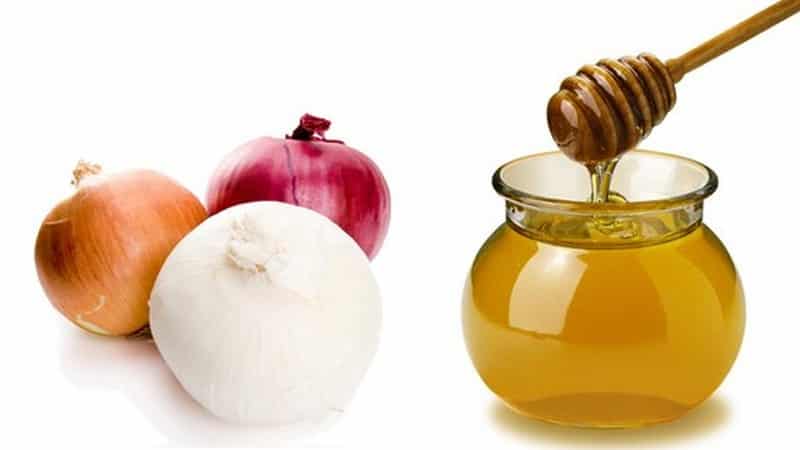
Onion juice
Processing the onion into juice allows you to preserve its healing properties.
There are several ways to make onion juice:
- Grind the peeled onions in a blender and place in gauze folded in several layers. Squeeze out the juice.
- Grate the onion. Place the onion pulp in a colander and rub with a spoon until all the juice has drained.
- Peeled and chopped onion place in the juicer container, turn on the device. During the extraction process, the juice will automatically drain into the glass, and the solid residue will fall into a separate container.
It is recommended to lubricate herpes with onion juice several times a day until the symptoms disappear completely. To prevent herpetic infection, the juice is taken orally, 2 tbsp. l. three times a day an hour after meals. The course lasts seven days, every three months.
Gruel
To obtain onion pulp, peeled onions are crushed using a blender or grater, the juice is separated from the solid part through gauze folded in several layers and a sieve.
This paste is used as inhalation for colds, tonsillitis, and pharyngitis.
Instructions:
- Place the chopped onion in a clean, dry container.
- Cover your head with a towel and inhale the volatile substances released by the onion for 5-10 minutes. Breathing should be smooth. After taking a deep breath, hold your breath for 1-2 seconds, then exhale as much as possible.
- Repeat the procedure in the morning and evening until complete recovery, but no more than 7-10 days in a row, unless otherwise specified by the doctor.
Fresh onion pulp is applied to hemorrhoids, wounds, cuts, abscesses, abscesses, boils.

Decoction/infusion
A water infusion or alcohol tincture of onions is used as an anthelmintic.
How to prepare a water infusion:
- Peel a medium-sized onion, chop finely, pour 250 ml of warm boiled water.
- Leave overnight, covered, in a cool, dark place. Strain in the morning.
Adults take 100-125 ml twice a day (in the morning on an empty stomach and in the evening) for 3-4 days.
Alcohol tincture recipe:
- Fill a glass container halfway with chopped fresh onions.
- Pour in vodka or alcohol. Close the lid.
- Leave in a warm place for 10 days, avoiding direct sunlight.
- Take 1-2 tbsp of strained tincture. l. twice a day, half an hour before meals.
The alcohol infusion is useful for people suffering from urolithiasis, as it has diuretic and analgesic properties.It also helps restore liver function, relieves symptoms of diseases of the gums and tissues surrounding the tooth (for periodontitis, stomatitis).
An infusion of onion peels reduces the frequency and intensity of cough. To do this, the peels of 10 onions are washed, placed in a saucepan and simmered over low heat with the lid closed for about an hour. Add a little honey to the strained broth. Take half a glass three times a day half an hour before meals.
Compresses
Onion compress is used in the complex treatment of osteochondrosis, radiculitis, rheumatism, arthritis and arthrosis of various origins. In such cases, onions reduce the severity of pain, eliminate the inflammatory process, relieve swelling, and increase the range of motion in the affected joint.
How to make a compress:
- Using a blender (grater), chop the onion and black radish. Mix in equal proportions and stir.
- Place the mixture in gauze folded in several layers and apply to the sore spot.
- Line the top with wax paper or plastic.
- Fix the compress to the body with a few turns of the bandage and wrap it with a warm scarf. Hold until a strong burning sensation appears.
- Then remove and wipe the skin with a damp towel. Apply anesthetic, anti-inflammatory, warming ointment or any other drug prescribed by a doctor to dry skin.
Baked and boiled onions
Baked onion has proven itself well for the treatment of hemorrhoids and skin wounds:
- Cut the onion in half, place cut side down on a baking sheet lined with foil, bake in a preheated oven for 30-40 minutes at 180-200°C until golden brown.
- Apply warm onion leaves to the affected area and replace with new ones as they cool.
The timing of treatment is agreed upon personally with the doctor, since the result depends on the stage of the disease, the characteristics of the body, and its response to the treatment.
Boiled onions are used to prepare a remedy for the treatment of constipation, alleviating the severity of symptoms of gastrointestinal diseases of an erosive and ulcerative nature.
Application in cosmetology
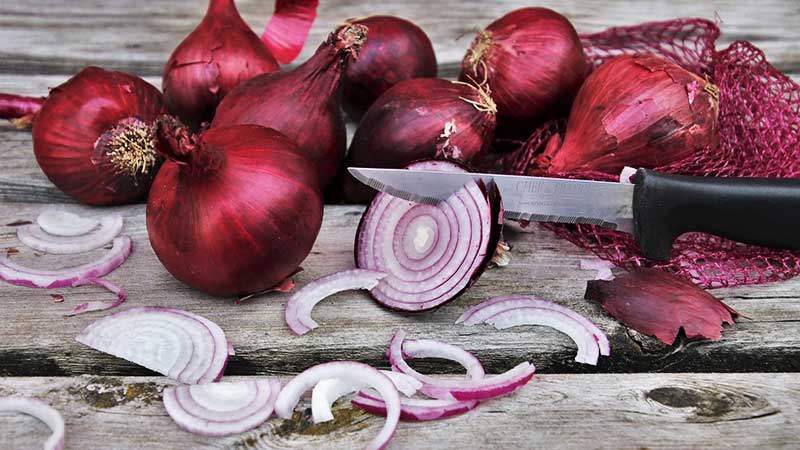
Onion is a well-known cosmetic product in many countries around the world. Freshly squeezed juice is used to treat alopecia, dandruff, baldness, and strengthen hair roots. If you rub onion juice into your scalp for 20-30 days, hair They will become silky, shiny, and begin to grow more actively.
For reference. The product should not be kept on the scalp for longer than 20-30 minutes. With longer use, skin irritation may occur due to the presence of essential oils in the composition.
For facial skin, use fresh onion juice or gruel.
- tones;
- eliminates dryness and flaking;
- stops the aging process;
- stimulates collagen production;
- neutralizes puffiness and dark circles under the eyes;
- brightens;
- reduces the severity of pigmentation and the number of freckles.
A simple way to provide facial skin care at home is to wipe previously cleansed and dry skin with onion juice daily. Masks are made from onion pulp once a week.
Cooking methods:
- Finely chop half the onion and mix with chopped parsley in equal proportions. Leave in the refrigerator overnight. In the morning, add 2 tbsp to the onion mixture. l. cosmetic clay. Apply to face and neck for 20 minutes.
- 2 tbsp. l. Combine grated pear with the same amount of onion juice, add 50 ml of milk, mix everything. Apply the mask to your face and leave for 20-25 minutes.
- Mix onion and carrot juice in equal proportions, add the yolk of one chicken egg and 1 cup of olive oil.
Contraindications and possible harm
Excessive consumption of onions and juice from them can cause health problems: nausea, vomiting, headache, weakness, fatigue, general malaise, exacerbation of chronic gastrointestinal diseases.
The most frequently reported side effect of onion-based recipes when applied externally is allergic reaction in the form of redness, peeling of the skin, rash, itching, swelling.
Onions are not used as a medicinal raw material by people with individual intolerance to the product.
Eating and taking juice, infusions, and onion-based decoctions is contraindicated in the presence of the following diseases:
- peptic ulcer of the stomach and duodenum in the acute stage;
- renal and liver failure;
- severe pathology of the urinary system;
- gastritis with high acidity;
- hypotension.
Conclusion
Traditional medicine uses onions for the treatment and prevention of various painful conditions. It is used for coughs, flu, colds, hemorrhoids, worms, osteochondrosis, hypertension, atherosclerosis, burns, wounds and other diseases.
In order not to harm your health, before starting onion treatment, consult a specialist to eliminate possible contraindications and choose the optimal application regimen.